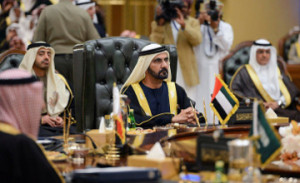
In order to understand the lapse that has happened to the Saudis yet again, we need to go back a couple of years. The project for a military and political union was initially announced in December 2011 by King Abdullah in his address to one of the previous GSO summits in Riyadh, and that was allegedly done in response to the increasing “Iranian threat” as it was perceived back then by the Saudi rulers.
However, this initiative – not overtly but absolutely definitely – was designed to consolidate the hereditary monarchies around the Wahhabi Saudi Arabia and, under the guise of confrontation with Tehran that was being approved by Washington at the time, to try and maintain in power the Sunni monarchy regimes facing the explosive wave of changes in the Arab world – the wave that had been steadily growing since the end of 2010. The fight against Iran looked in this context as a pretty good motivator. Internal problems could be easily described as the scheming of the enemies, who allegedly wanted to “ignite turmoil” by using Shiah population in a number of Arab countries of the Persian Gulf. Such a line, among other things, allowed for unhindered export of their own jihadists (whose number in Saudia Arabia is quite high as the events of 11 September 2001 had demonstrated) to the external fronts of the fight against “Shiah heretics”, such as the Syrian and Iraqi fronts, and that would weaken the pressure exerted by radicals on the domestic political situation. This was later confirmed by Syria’s further experience and by that of Iraq as well.
The idea that the creation of a military and political union had been planned, in the first place, as a way to prevent the swapping of the dynasty regimes in the Gulf states by electoral ones was also proved by the initiative simultaneously put forward by the Saudis to expand the GSO by two other Sunni monarchies – those of Jordan and Morocco, with the latter being thousands kilometres away from the Persian Gulf. But Riyadh did not worry too much about that. Such an “extraordinary move” would have enabled creating at once a coalition of Arab hereditary monarchies which would be backed up by the above-mentioned military and political union.
Such interpretation also rests on the implementation in 2011 of the operation Shield of the Peninsula, which was initiated and led by the Saudis, in the course of which a contingent of GSO forces entered the Kingdom of Bahrain, with the former mainly consisting of Saudi troops. Under the pretext of the fight against external interference on the part of Iran, they managed back then to “freeze” the crisis (which had broken out on the island as a result of the “Arab Spring”) between the ruling Sunni family of Al-Halifa, strongly dependent on the KSA, and the Shiah majority demanding political rights and redistribution of power authorities in their favour.
(to be continued)
Maxim Egorov, a Middle East political columnist, exclusively for the New Eastern Outlook online magazine.
